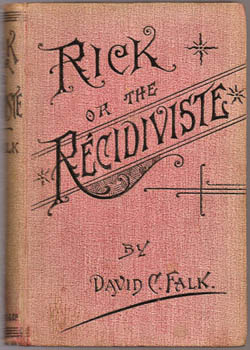
FALK, David G. Rick; or, The Recidiviste. A Romance of Australian Life. London, Trischler 1891. Octavo publisher's textured pink cloth blocked in black (spine and around the edges faded). Patterned endpapers browned, signs of use but a pretty good copy. Au$375
Only edition of this elusive thriller set in and around Melbourne that exploits that timeless Anglo-Australian characteristic - fear of foreigners. In this case it's the Recidivistes, escaped French convicts from New Caledonia. Falk prefaces the book with an extract from the Melbourne Argus noting the disquieting increase of French convicts in Australia. Rick and the Recidiviste are not the same person, Rick is an orphaned young woman with a mysterious past and the Recidiviste is Ranq, by name and nature. The young detective Sprowde solves both problems before the most overstretched deathbed scene I've skimmed in years and a gently melancholic but happy enough ending.
Falk appears to have written a fair bit for papers and journals but only two novels were published as far as I can work out. Trischler & Co. used to be the Hansom Cab Publishing Co and published a few Australian authors during its brief life.

BRADLEY, Charles. The Red Cripple. A Tale of the Midnight Express. Melbourne, George Robertson & H.W. Mills 1891. Octavo publisher's colour illustrated wrapper; [6],186pp. Price changed by hand from one to two shillings. An outstanding copy. Au$1500
First edition of this scarce, busy murder mystery, a tangle of disguise, false identity, astounding coincidence and extended comic relief. Despite the often repeated note this has nothing to do with a diamond robbery but in passing near the end. Almost all of this takes place on the Manchester-London train - though the unsolved murders started seven years ago - with hair-raising action, comedy, tragedy and mystery piled upon mystery.
An all round Melbourne production, though disguised as the account of detective Medway of Scotland Yard sent to Bradley in Melbourne. Bradley was in theatre - manager of the Walter Bentley company's tour of Australia and New Zealand at about this time. He was busy in 1891: he published another thriller, had plays produced and, at the end of 1892 went off to conquer America with his plays. He puffed the forthcoming New York production of 'The Gold Escort' - the introduction of Australian theatre to American audiences. I can't discover that America ever saw the drama, action and slaughter promised but Bradley does surface here and there over following decades as a manager, producer and maybe playwright. If he'd managed to carry off setting the whole thing on the train this would now be hailed as a pioneering modernist work.
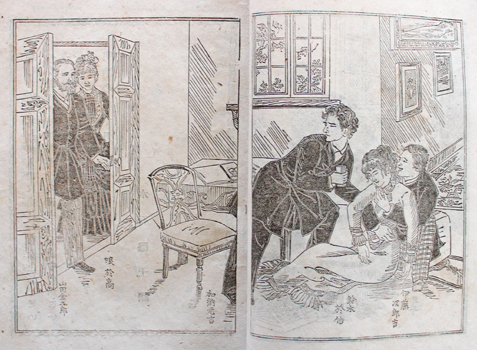
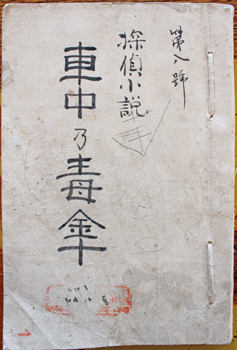
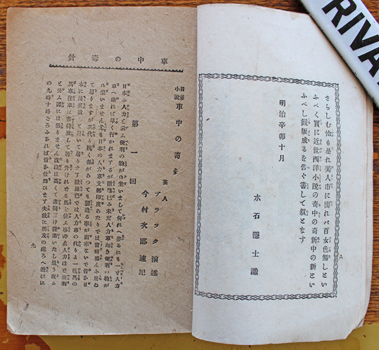
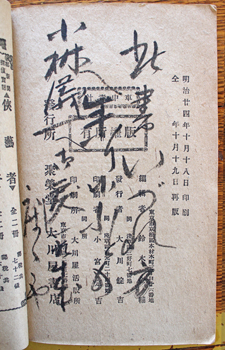

Henry James Black. (Burakku Kairakutei). Du Boisgobey, Fortune. : [Shachu no dokubari : Tantei shosetsu]. Tokyo, Okawa 1891 (Meiji 24). 220x145mm, without original wrapper in a later but old light card wrapper lettered by hand; 190,[4 advert]pp; 11 double page illustrations. Brushed inscription over the colophon page, certainly read, natural browning of the paper but a respectable enough and solid copy. Au$650
A detective story told as a serial to an audience by a gay Australian who became a professional Japanese story teller and actor, taken down in shorthand and published as this book.
Black was born in Adelaide and arrived in Japan in 1865 at the age of almost seven - his father, up until now a singer, had bought into the Japan Herald. Henry seems to have grown into something of a no-hoper in the eyes of some of his family at least and rather than settle to respectable work became first a proponent of progressive reform, like his father, then a professional rakugoka - story teller - and even a kabuki actor playing women. His reaction to his siblings' disapproval was to change his name to Burakku Kairakutei (Pleasure Black), marry a Japanese woman and become a Japanese citizen.
Ian McArthur, Black's biographer, quotes from a police report made at this time that he was living in "virtually a husband and wife relationship" with a young Japanese man but otherwise there was nothing untoward to worry about. At the height of his fame - 1891 and 92 - maybe six or seven of these stenographic novels were published and other stories appeared in newspapers. It's a bit hard to unravel as a couple appeared more than once with different titles. Even the concise and acerbic Edogawa Rampo gets muddled and misled trying to work out a bibliography at the end of his 1951 essay translated as 'Fingerprint Novels of the Meiji Era'. He cites another essayist who wrote on Black and said he had five of his books, Rampo had only three.
This handful of detective stories or thrillers was bracketed by two translations or adaptations of novels: Mrs Braddon's Flower and Weed in 1886 and Dickens' Oliver Twist in 1895. Of the thrillers from these two boom years, two are known to be adapted from stories by Mrs Braddon and one - this one - from a story by Fortune du Boisgobey. Boisgobey's 'Crime de l'Omnibus' appeared in 1881 but Black was much more likely to work from a cheap English translation published in New York in 1882 or by Vizetelly in 1885 - titled 'The Mystery of an Omnibus' and 'An Omnibus Mystery' respectively. I like Black's title better which translates more or less as The Poisoned Needle in the Coach.
These stenographic books - sokkibon - were hugely popular, distributed largely through lending libraries and have a pitiful survival rate. They are credited with playing a large part in transforming Japanese literature from the classical and formal to colloquial.
This is not the board cover edition, it is printed from what looks to be the same setting on larger, coarser paper with added running titles and was undoubtedly issued in wrappers. The colophon says that it was printed on the same day (October 19) as the original which could, I guess, be true. Worldcat, when nudged, finds two entries - both the board edition - the NDL in Japan and the NLA in Australia.
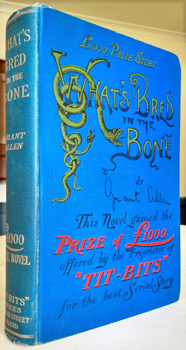
ALLEN, Grant. What's Bred in the Bone. ?1000 Prize Novel. London, Tit-Bits 1891. Octavo publisher's decorated cloth blocked in gilt, ochre, red and black. Spine a touch darkened, minor signs of use; pretty good. Au$400
First edition of this maelstrom of a thriller. "What's Bred in the Bone is what you can recommend to a friend .. who .. likes his novels hot and strong," said Longman's Magazine and the reviewer in The Speaker, pausing for breath at the end of a racing list of incidents, tells us that "this is only the second chapter and Mr Grant Allen has enough incident to last him for forty-five chapters."
Murder, disaster, fraud, identical twins of unknown predigree who share the same toothaches, the diamond fields of South Africa and young English lady with an atavistic urge for snake dancing ... many of these things, but not all, are down to the influence of heredity. The rest are down to the author.
This novel was a hit so it's easy enough to find delapidated copies and reprints but not decent original copies.
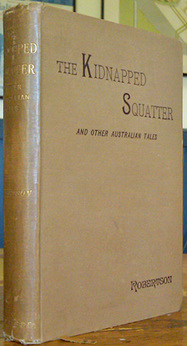
ROBERTSON, Andrew. The Kidnapped Squatter and other Australian stories. London, Longmans 1891. Octavo, fresh in publisher's fawn cloth (spine rubbed and a touch worn at the tips). A 24 page 1891 publisher's list at the end. A pretty good copy, uncommon as such. Au$200
First (only?) edition of Robertson's first book, a gathering of four stories. Austlit separates the Rev Andrew Robertson, essayist, from our author; they had been blended by Miller and Macartney. The Spectator, relieved to find no bushrangers, gave this a good, barely patronising, review - remarkable treatment for a colonial book.
I'm less forgiving. It is outrageous providence - a lazy author I say - that catches the miscreants in the title story, not a 'tec or bloodstain in sight. Jack Reeveley, the long piece of the book, does have a detective - one who quotes Shakespeare in his report - violence, convoluted mystery and outrageous coincidence enough for any three books.
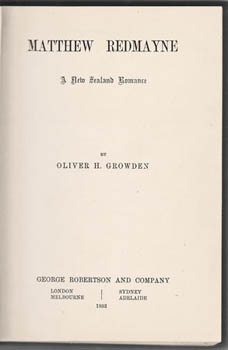
GROWDEN, Oliver H. Matthew Redmayne. A New Zealand Romance. London, Melbourne &c, George Robertson 1892. Octavo publisher's red cloth (spine a touch faded or rubbed). Quite a good copy. Au$350
Only edition. A thriller involving a woman falsely accused of murder, an insane sister, secret correspondence, bigamy and much more. "To give an outline of the plot would be difficult, owing to its complexity, devious windings, and numerous bypaths" writes The West Australian (14th July 1893) who gives it a good review and notes that the author is believed to be a young public servant resident in Perth. Growden published more fiction in The West Australian and the Western Mail but this seems to be his only book.
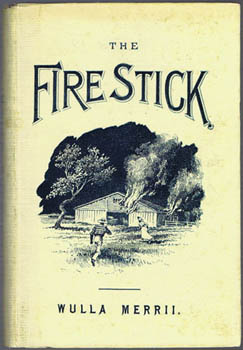
[CAMERON, John?]. Wulla Merrii. The Fire Stick: Incidents in the shearer's strike. A tale of bush life. n.p. [Brisbane 1893?]. Octavo publisher's illustrated boards. A few small knicks, a rather good copy. Au$100
The attribution to Cameron seems fairly well accepted. A virulently anti-union novel so it's no surprise that neither the printer nor author dared put their name on it (both the title and last leaf appear to be cancels - redone without colophon or any other details). Can we presume that fear of retribution also accounts for the fact that so many copies were clearly never circulated until recent decades? Surely it couldn't be the writing, plot, paper thin characters: villainous unionists and cartoon blacks? Plenty of other novels have done well on worse.
Cameron was a pastoralist and politician, a leader of the anti-union movement (they "aimed at nothing short of REVOLUTION") and a central figure in the strike. A confirmed White Australian he was known to declare, I gather while campaigning for office, that "I have never believed in the principle of one man one vote, and nothing will ever convince me that men should have equal voting rights".
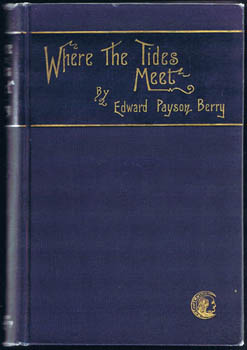
BERRY, Edward Payson. Where the Tides Meet. Boston, Arena Publishing 1893. Octavo publisher's cloth; a most misleading nautical extra illustrated title. A rather good copy. Au$400
First (only?) edition? A New York thriller that isn't in Hubin and should be. Mostly set in the grimmer parts of New York and featuring a wealthy young do-gooder - fitting the Arena imprint - we have a murder, a detective, a scheming lawyer, a pickpocket with a monkey accomplice ... what else do we need? A gunfight? a crushed and bloody corpse? a river of blood? Can do.
Being published by Arena may not have guaranteed your novel would die in dark and perpetual obscurity but it got you well on the way.
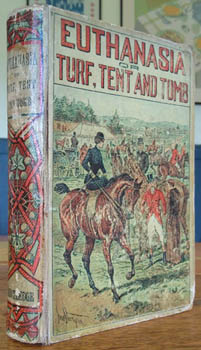
Euthanasia Or Turf, Tent and Tomb. London, Routledge 1893. Octavo publisher's illustrated glazed boards (rubbed with wear to edges and hinges). Certainly read but a very decent, even proper, copy. Au$250
First edition, yellowback issue. It was also issued in cloth at a higher price. A title for every reader; the cover of this romantic thriller might convince us that is a book for the horsey set but what is that monk doing on the field? Newcastle University attributes this to E.W. Hornung. What did their librarian know that no-one else does?
What shines through here is that the aristocracy must be judged by different standards to the rest of us. The hero, the poor younger brother Lord George, is seen as the "soul of honour and loyalty and truth" by all around him while he behaves appallingly by lower class standards. The Euthanasia of the title is indirect, by way of expiation, but I guess it is there. The rest of the title takes place in England, Hungary and Naples. Despite its inclusion in Hubin there is no murder here except of ethics.
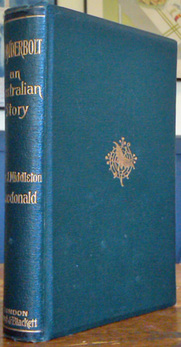
MacDONALD, Rev. J. Middleton. Thunderbolt. An Australian Story. London, Hurst and Blackett [1894]. Octavo publisher's dark green cloth. A rather good, bright copy. Au$225
Only edition of this thriller - a somewhat sticky novel mixing history into the bushranging thrills - in which we meet the chivalrous and dashing Thunderbolt and equally dashing Major in pursuit, the well bred but unspoilt young ladies, and the rough but true bushmen and diggers. Appended is a short glossary of Australianisms.
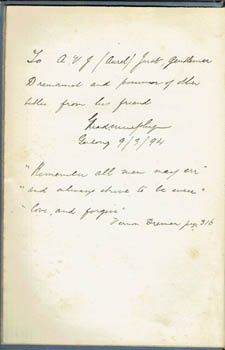


MURPHY, G. [George] Read. Beyond the Ice. Being a story of the newly discovered region round the north pole. Edited from Dr. Frank Farleigh's diary. London, Sampson Low & Melbourne, Hutchinson [1894]. Octavo publisher's illustrated blue cloth (two small blobs of wax on the front cover, marks on the back). Somewhat canted, not a bad copy of a book guaranteed to respond badly to handling. A signed presentation, dated March 1894, from Murphy to Geelong lawyer Aurel Just, "gentleman, Dremanist and possessor of other titles," with a quote from his character Vernon Dreman. Au$950
Only edition of this polar utopia and dystopia which Geelong author Murphy - I suspect simple perversity - took to the opposite end of the world in defiance of the usual Australian practice of heading south. Heaps of scientific advances and flying machines as expected but reform and enlightened progress can only go so far: adult women are enfranchised until they marry, then the possible conflict between husband and wife is not worth the candle.
"The chief characters seem to spend a deal of unnecessary time in consuming oysters and brown bread" warned the North Melbourne Courier and West Melbourne Advertiser in an otherwise warm review while suggesting it would be commercially more canny to set the book in central Australia.
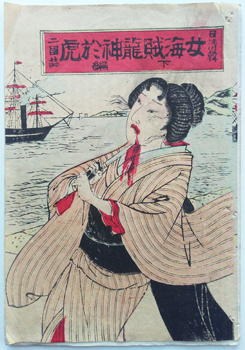
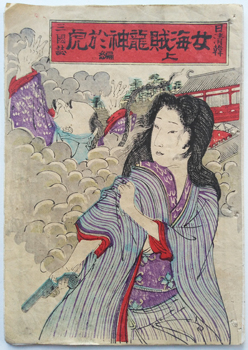
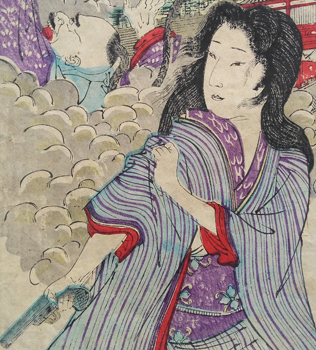


Kyokaen Shujin (?) [On'na Kaizoku Ryujin Otora] Takahashi Yutaro 1894 (Meiji 27). Two parts 24x17cm; each 8pp plus a colour woodcut cover; a full page illustration in the first part. Au$300
This short bloodstained thriller about this glorious woman pirate forms two issues of the obscure magazine, Nisshin Kan Mikunishi. Forget finding a record of this tale, first find a record of the magazine; I found mention of a single issue in the Tokyo Keizai University library.
I hope the woman on the second cover is not our pirate but I fear it is. I need someone to read it to me before I can tell you.
Yamashita Taihei writing about fighting women in Meiji and Taisho novels discussed a 1903 female pirate novel by Emi Suiin which may owe something to ours. Yamashita describes the Emi novel as insane because the author was insane. I'm looking for a copy.
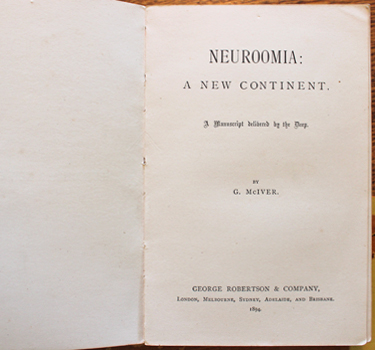
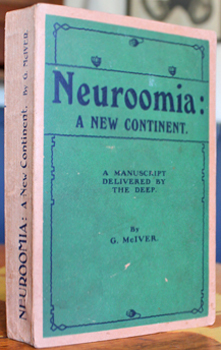

McIVER, G. [George]. Neuroomia: A New Continent. A manuscript delivered from the deep. Melbourne, George Robertson 1894. Octavo publisher's printed wrapper. A touch of wear to the bottom of the spine; a nice copy, outstanding for this book, usually found in gruesome shape. Au$2000
First edition, Australian wrappered issue to be precise. It appeared in cloth, boards, or wrappers, and with a London imprint. Neuroomia is a true utopia, larger than Australia, hidden in the centre of the Antarctic. I have remarked before on the crowds of stranded or lost travellers roaming around the Antarctic towards the end of the 19th century. It's a big place but surely they must have bumped into each other. And all those ancient and advanced civilisations must have been cheek to jowl.
I spent a bit of time wondering how much of this is naive and how much tongue in cheek, if not mocking. I'm undecided. But it's clear McIver understood well the form of imaginary travel: the hero must be a blockhead, otherwise nothing ever happens to interrupt endless sere and drear explanatory dialogues. He's made our hero an indefatigably bumptious, often offensive blockhead - and a serial mauler of lovely young women - so there's plenty of action.
Neuroomia is an impressively advanced socialist white middle class heaven, or would be if there was any religion. Women have liberty and equality but choose not to take any part in decision making and "are always careful not to abuse that liberty." Our hero was frightened by individual flying machines on his first day in Neuroomian society but that seems to have been a lost art by the next page. All travel from then is by ship, rail, or creature drawn carts - on a bewildering scale to be fair.
No more than two thirds of the way through our hero begins to be reflective and learn from his painful self inflicted lessons so overall consequence needs ratcheting up and we are introduced to prehistoric - to us, not the Neuroomians - cataclysms caused by a wandering planet, life on Mars, interplanetary migration and the source of life on earth. None of this gets too much in our way.
McIver, a schoolteacher at Macksville in northerly NSW when he wrote this, apparently made some money from it. If so, he wasn't spurred to produce more. Much later he wrote for papers and magazines, produced a memoir of his droving days, and a slim volume of verse near the end of his life.
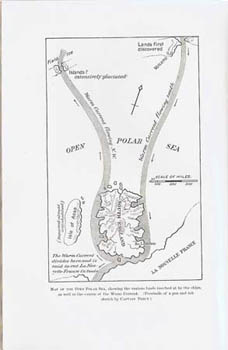
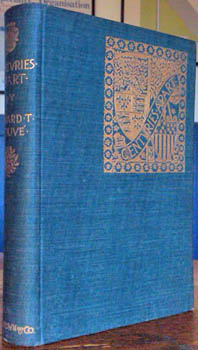

BOUVE, Edward T. Centuries Apart. Boston, Little Brown 1894. Octavo publisher's gilt decorated blue cloth; x,347pp, two maps and six plates. Minor signs of use but quite a good copy. Au$175
First edition. An Antarctic lost race, this time of comparatively recent origin - Tudor England. Toward the end of the 19th century Antarctica was one of the busiest spots on earth, what with lost races tucked in every crevice and lost mariners crawling all over the place. They must have bumped into each other but - like real explorers in central Asia - studiously ignoring each other's pack train quartered down the other end of whatever remote village, pretending they each were the only white men for thousands of miles - discretion was the better part of a thrilling narrative and silence was the tacit rule.
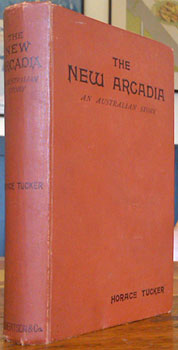
TUCKER, Horace. The New Arcadia. An Australian story. London, Melbourne &c, George Robertson 1894. Octavo publisher's brown cloth titled in black. Spine canted, minor signs of use. Floridly inscribed and signed by Tucker in 1897 to John Cuthbert Traill and "dedicated without permission to Mrs Traill." Au$350
First edition. More romantic thriller - with murderous, will tampering, downright communist villains - than utopian polemic but a serious utopian novel none the less; unusual for the time in that it is not set in the future, a lost world or another planet. It's the story of a number of idealistic settlements, including Amazona, a women’s community; makes short work of the attempted communist society and ends with the triumph of co-operation. But not so much personal triumph, quite a bit of melodramatic death occurs before then. As one reviewer noted, "the author has an unpleasant knack of killing amiable people."
All this is bound to a material if unsuccessful scheme. Tucker and Charles Strong promoted the resettlement of the unemployed in country areas and between 1892 and 1894 some 200 families were established in Tucker Village Settlements in Victoria. They failed for the usual reasons - lack of capital, a declining economy and mismanagement - but did see the Settlement of Lands Act (1893) enacted. Not in Hubin; it should be.
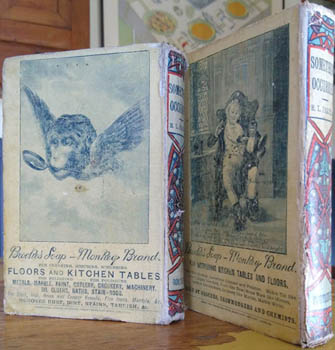
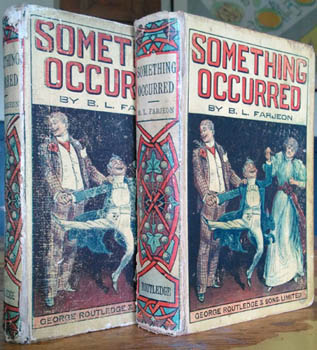

FARJEON, B.L. [Benjamin Leopold]. Something Occurred. [and] Something Occurred. Third edition. London, Routledge 1894. Two volumes colour illustrated glazed boards; the first with wear to edges and quite good the other more rubbed and worn about the edges. The first with 331pp and adverts dated July 1894; the second with 328pp on noticeably cheaper paper and adverts dated August 1896. Au$250
I want to make it clear that this is not my discovery, the work here was done by Rowan Gibbs. Now. The first copy here is, I believe, first edition - 1893 - sheets with a cancel title. There our interest might end except the next copy - the 'third edition' is revised and reset. The revisions aren't dramatic as far as I can see but they are there. That a publisher would take this on for a cheap yellowback reprint is a surprise to me. Something Occurred is a light fantasy involving magical snuff which owes more than a bit to the identity exchange and transformation novels of F. Anstey.
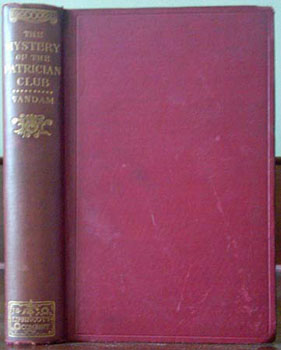
VANDAM, Albert D. The Mystery of the Patrician Club. Philadelphia, Lippincott 1894. Octavo publisher's red cloth. A little used: the cloth a bit smudged, the tips a little worn, but pretty good. Au$85
First American edition, contemporaneous with the English but being such a British detective tale of murder and, worse, cheating at cards, preference must be given to the London edition.
The Ballarat Star gave this such an enthusiastic review that there's not much mystery left; don't read it first.
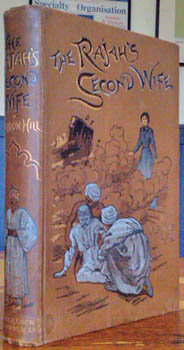
HILL, Headon. [Francis Edward Grainger]. The Rajah's Second Wife. London, Ward Lock 1894. Octavo illustrated brown cloth; two plates by Walter Stacey. Endpapers browned, the occasional smudge but quite a good copy. Au$175
First edition. A ripe melodramatic thriller embracing interracial marriage and dirty deeds in the slums and palace of Jhalwa.

MARCHMONT, A.W. Parson Thring's Secret. NY, Cassell [1895?]. Octavo grey cloth blocked in red and black. A rather good copy. Au$200
First edition? It doesn't seem to have been published in London until 1910. I found a couple of later American printings of this in OCLC, one renamed 'The Marlwych Mystery, or Parson Thring's Secret' but not this, and no British printing until a cheap sixpenny version in 1910.
"One of those exasperating novels which could never become a book, if the people concerned in it had the saving grace of common sense." (The Book Buyer).

MACKAY, Kenneth. The Yellow Wave. A romance of the Asiatic invasion of Australia. London, Bentley 1895. Octavo publisher's cloth; folding map and six plates by Frank P. Mahony (two form a double page spread in two panels). Edges rubbed but a rather good copy. Au$1250
First edition, the same sheets were re-issued a couple of years later as an 'Australian Edition', either form is hard to find. This is by no means the first invasion of Australia novel - an earlier generation's fear of the Russians had produced at least two, and Robert Potter had, in The Germ Growers (1892), written what was possibly the first ever alien invasion novel - but it is early for the Yellow Peril.
The Japanese defeat of Russia a decade later sparked a number of invasion novels but the rabidity of the White Australia movement had produced little more than inflamatory articles and cartoons until this. The Russians are not forgotten - they figure at the centre - but it is the Mongol horde that will (the book is set sixty years into the future) sweep down through Queensland using the land grant railways. This is a long and complicated novel, as much a romance as political hobbyhorse.
Mackay was a politician who had published some outback fiction and horsey verse to a good reception - when was the last time you saw verse reviewed in newspapers' sporting pages as quoted at the end of the book? Here he happily mixes in society life, horse racing and a tragic love affair.
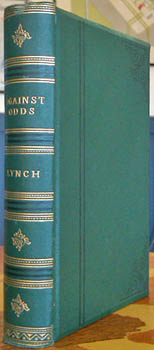
LYNCH, Lawrence [E. Murdoch van Deventer]. Against Odds. A detective story. London, Ward Lock [c1895]. Octavo green cloth blocked in black and gilt; frontispiece. Title browned but an excellent bright copy. Au$75
A re-issue in Ward Lock's uniform series of thrillers which could consist of the first edition, a reprint, or a re-issue of sheets with a new title page which, as this title page is on very different paper to the rest of the book, is the case here. The book first appeared in Chicago, then London, in 1894.
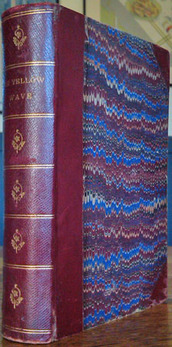
MACKAY, Kenneth. The Yellow Wave. A romance of the Asiatic invasion of Australia. London, Bentley 1895. Octavo contemporary half roan (a repair to the back hinge); folding map and six plates by Frank P. Mahony (two form one view in two panels). A few minor signs of use but a pretty good copy. Au$750
First edition, the same sheets were re-issued a couple of years later as an 'Australian Edition', either form is hard to find. This is by no means the first invasion of Australia novel - an earlier generation's fear of the Russians had produced at least two, and Robert Potter had, in The Germ Growers (1892), written what was possibly the first ever alien invasion novel - but it is early for the Yellow Peril.
The Japanese defeat of Russia a decade later sparked a number of invasion novels but the rabidity of the White Australia movement had produced little more than inflamatory articles and cartoons until this. The Russians are not forgotten - they figure at the centre - but it is the Mongol horde that will (the book is set sixty years into the future) sweep down through Queensland using the land grant railways. This is a long and complicated novel, as much a romance as political hobbyhorse.
Mackay was a politician who had published some outback fiction and horsey verse to a good reception (when was the last time you saw poetry reviewed in newspaper sporting pages? - quoted at the end of this book). Here he happily mixes in society life, horse racing and a tragic love affair.
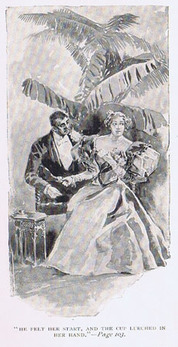
PHILIPS, F.C A Question of Color. NY, Stokes 1895. Narrow octavo publisher's cloth; [4],148pp, frontispiece. The first in Stokes' Bijou Series. Au$75
First American edition, contemporaneous with the London edition. This begins as an unremarkable light romance of the period, until the question of colour intrudes: the young woman throws over her impecunious fiance to marry a rich African prince, brought up in England and 'University' educated. Towards the end we seem to be heading into a crime thriller and we finish with satisfying tragedy.
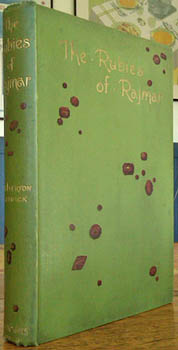
EASTWICK, Mrs. Egerton. The Rubies of Rajmar or, Mr. Charlecote's Daughters. A romance. London, Newnes 1895. Octavo publisher's illustrated green cloth (a touch dusty). A rather good copy. Eight page publisher's list at the end announcing this as just ready. Au$250
First edition of this jewel ridden thriller of murder and interracial marriage. The Guardian was kind: "There is plenty of sensation ... mysterious Indians and secret passages, and ... a murder, and altogether the authoress contrives to keep up a most praiseworthy atmosphere of creepiness throughout the book." The Athenaeum was more guarded: "not without interest, and the sense of mystery is fairly well sustained" - but not cruel. Unlike H.G. Wells in the Saturday Review: "Mrs. Eastwick imitating Wilkie Collins is quite unforgivable." The usually reliable Spectator shocked me, the staff must have been on a bender: "A story, indeed, that is readable from the first page to the last, disarms criticism".
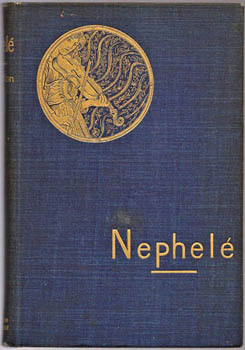
BOURDILLON, Francis William. Nephele. NY, New Amsterdam 1896. Octavo publisher's decorated gilt cloth. A touch browned around the edges but a very good copy. Au$100
First American edition, contemporaneous with the English edition. Not quite a haunted violin thriller as suggested by the cover illustration but a haunted piece of music - and a violin does play a part.
  1 2 [3] 4 5 6 1 2 [3] 4 5 6   |